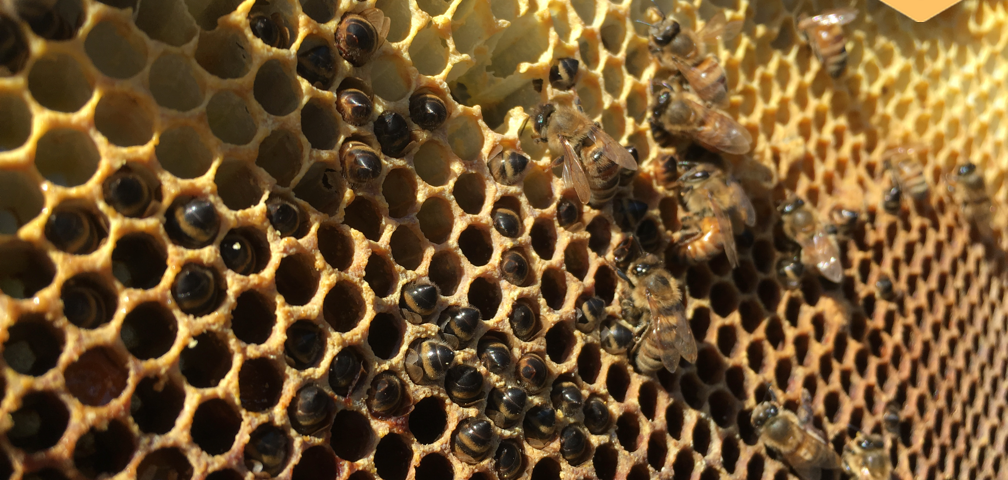- All-In-One Beekeeping for the Bees
- +1-608-728-8233
- info@beepods.com
How Honey Bees Survive Winter by Regulating Their Temperature in a Cluster

The behavior of bees is affected by temperature. There are three temperatures that are important to the bees: 1) air temperature, 2) body temperature, 3) the cluster temperature.

Heater Bees. These bees died in the wintertime while actively attempting to warm up the honey comb around them by decoupling their wing muscles and shivering to produce heat.
When the temperature of the air is between 57-100°F, honey bees are usually eager to work. However, they cannot fly very well when the temperature is below 55°F. Some sources state that flying activity does not take place outside of the 50-110°F air temperature range. On very hot days, honey bees will congregate on the outside of the hive if the hive is not well ventilated and if it gets too hot inside the hive.When it is especially hot, honey bees prefer not to work. However, on very cold days, for example, throughout the winter months in places where it snows, bees do something much different.
Honey bees do not hibernate. Instead, here’s what you can expect from your honey bees in the winter:

When the air temperature is around 64°F, honey bees can begin to cluster together in the hive to keep the queen and themselves warm. At outside air temperatures of around 57°F, the honey bees will cluster more closely together and the exterior of the cluster with appear more compact. When temperatures drop to 23°F or below, the bees on the inside of the cluster begin vibrating their wing muscles to generate heat, which aids in bringing up the internal core temperature of the cluster. The bees along the outer shell of the cluster remain motionless, acting as a layer of insulation.
Honey bees make no attempt to maintain the temperature in the domicile outside the winter cluster. The temperature within the cluster itself varies. Warmer bees from the inside of the cluster continually change places with the colder bees along the outer edge of the cluster to allow the colder bees to warm up.
 One source states that the temperature of the cluster is actually not closely correlated with the outside air temperature. However, they say that “a pronounced change in the temperature during the day will cause an appreciable change in the cluster size and temperature”.
One source states that the temperature of the cluster is actually not closely correlated with the outside air temperature. However, they say that “a pronounced change in the temperature during the day will cause an appreciable change in the cluster size and temperature”.
The optimal core temperature of a honey bee cluster in a winter hive is 95°F (35ºC). 81°F (27°C) is the average temperature observed on the inside of a cluster, while 48°F (9°C) is the average temperature of the exterior shell of the cluster. The highest temperature of a cluster that has been observed is around 100°F (37.8ºC).
The minimum temperature of the inside of a cluster has been found to be around 55°F (12.8ºC), while the minimum temperature of the outside of the cluster that honey bees can tolerate has been observed to be around 46°F (7.8ºC). Some sources state that the outermost temperature tolerance of a winter honey bee cluster is 44°F (6.7ºC).

Another way that honey bees regulate the temperature of their hive is through the use of “heater bees”, whose job it is to vibrate their abdomens, allowing them to vigorously move their muscles to heat their bodies. This action can bring the bee’s body temperature up to about 111°F (44°C), which is 16°F (9°C) higher than their normal body temperature. These bees will crawl inside of empty cells to keep the surrounding cells warm. One single heater bee is thought to have the ability to keep up to 70 adjoining cells warm.
It has been observed that weaker colonies might starve in winter even though they have plenty of honey in the bar right next to the cluster. This is because the bees are unable to generate enough heat to allow the cluster to spread out over the adjacent comb. However, it has been seen that stronger colonies can more easily change cluster location and size.
In the winter, cleansing flights will occur if the air temperature is above 44°F (6.7ºC), as the body temperature of the bees will be slightly higher, so it is still possible to perform short flights. If the body temperature of the bee falls below 50°F (10ºC), paralysis of the bees’ muscles can begin to take place. At a body temperature of 45°F (7.2ºC) the bees appear “frozen”, meaning their muscles can no longer move.

Two Beepods top bar hives deep in the Winter snow.
Sources:
Root, Amos I and Root, Ernest R. (1919) The ABC and XYZ of bee culture. Bee Culture Magazine
University of Kentucky Entymology Department (2017, June) “Basic Beekeeping Operations” [Blog post]
Anonymous (2009, February 29) “Bee cluster, flying and active temps” [Blog post] Bee Hive Journal
Brad James
Latest posts by Brad James (see all)
- Where does pollinator week come from? A brief History of Pollinator Week and its impact on supporting pollinators - June 17, 2019
- Honey Bee Breeds and Their Attributes - March 2, 2018
- My 3-Year-Old Daughter Loves Bees - December 5, 2017



